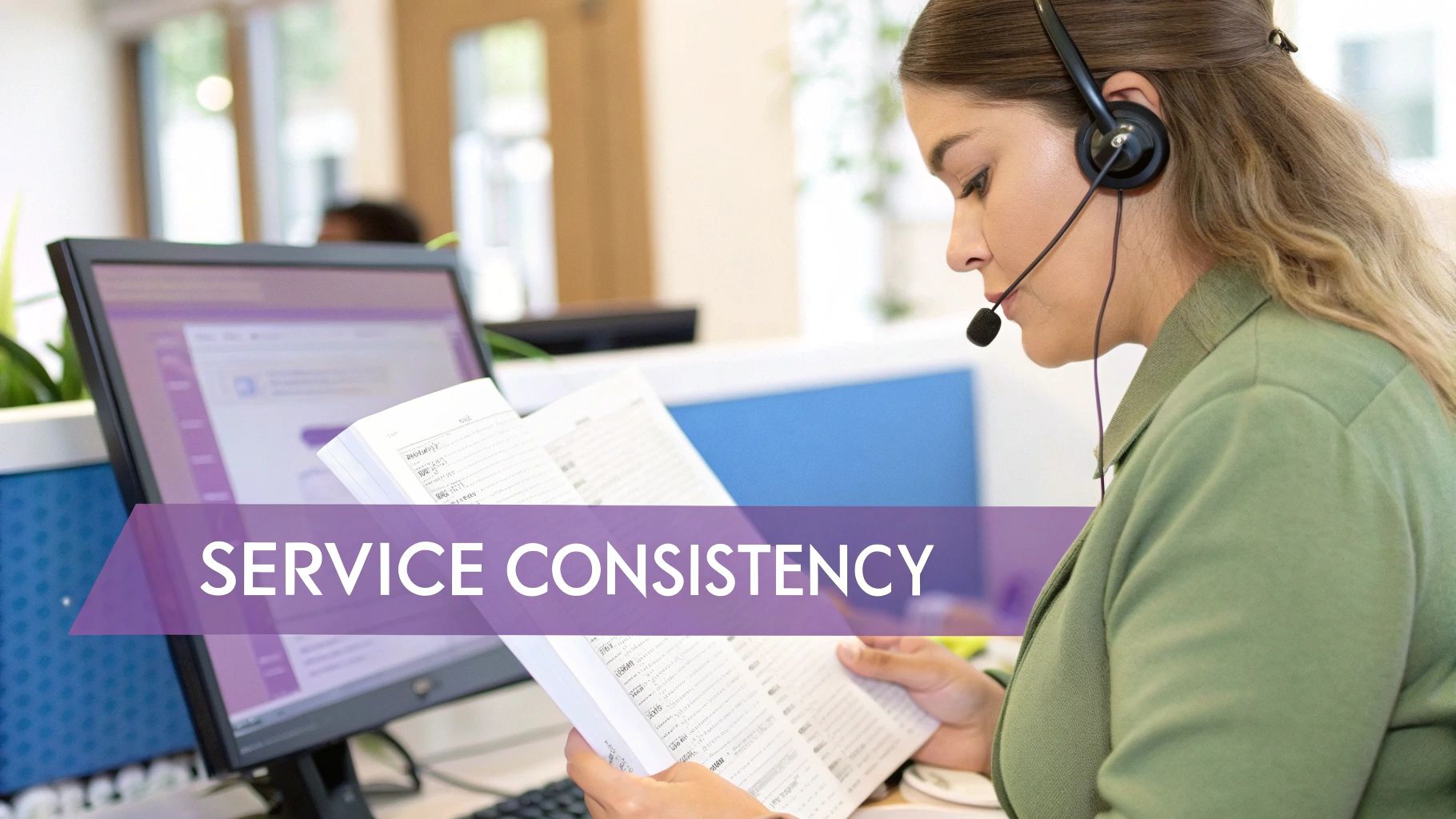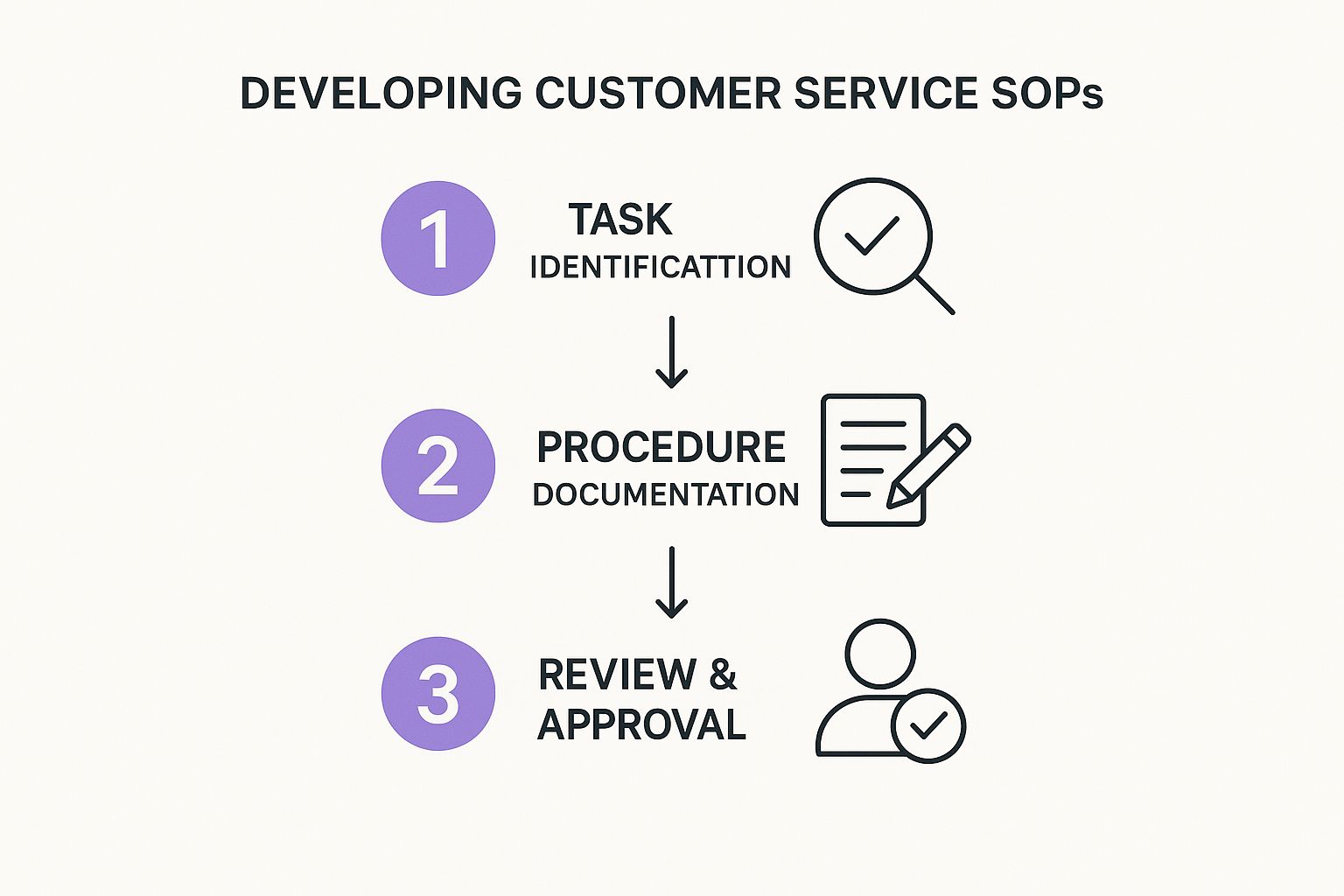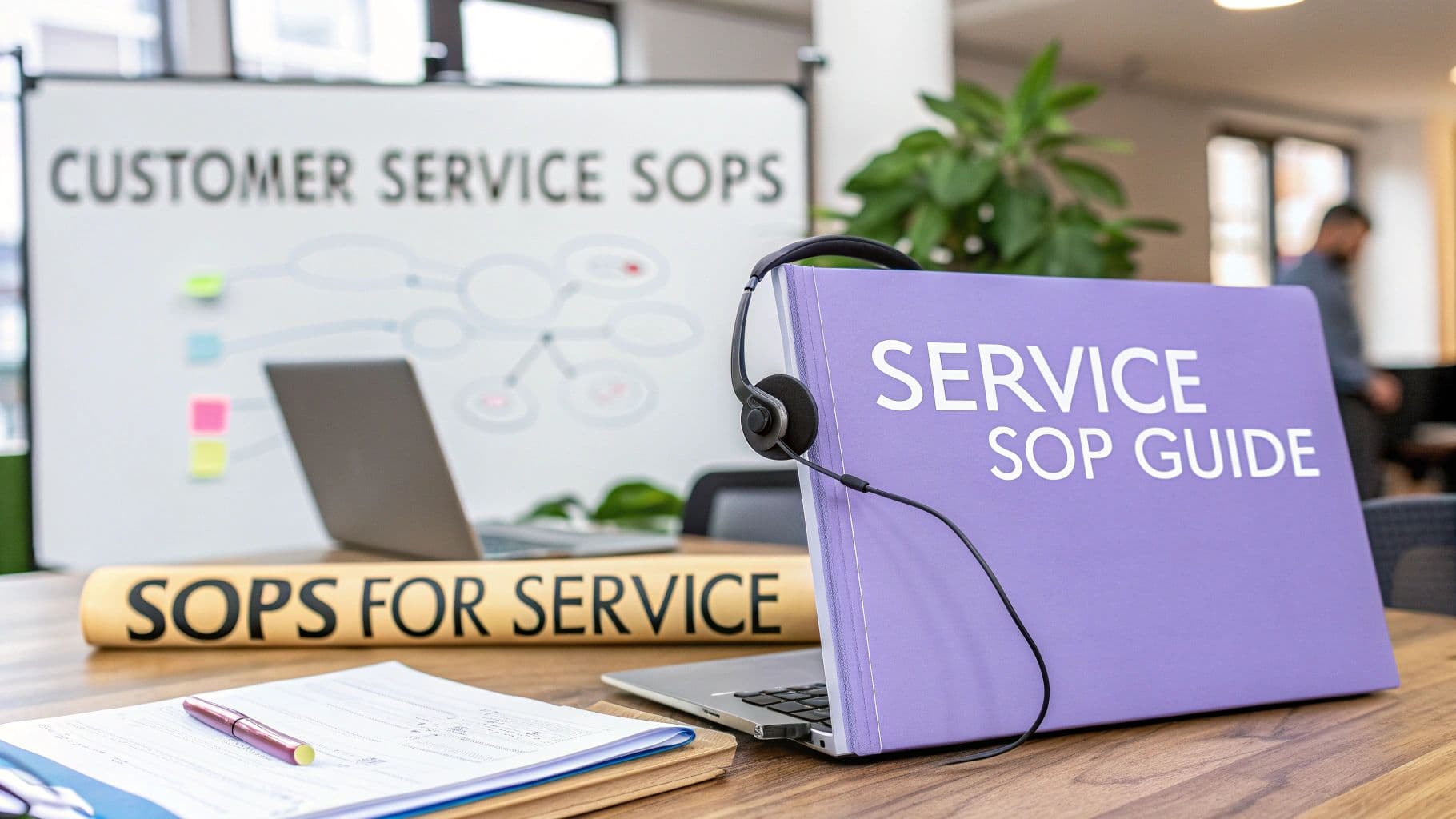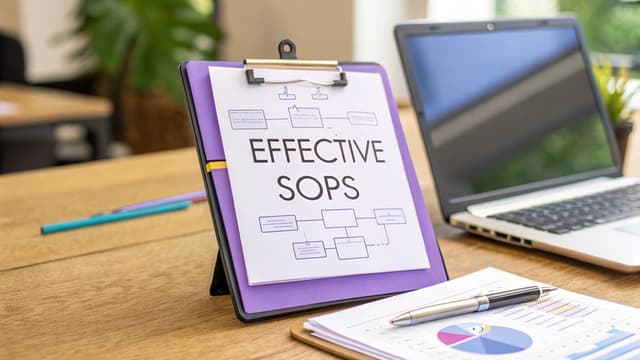Let's be honest, "Standard Operating Procedures" sounds incredibly dull. Most people picture dusty binders filled with rules nobody reads. But in customer service, SOPs are anything but boring—they're your team's secret weapon.
Think of them as a shared playbook. Instead of a rigid script, they're a set of clear, repeatable steps that guide your team through common (and not-so-common) customer situations. This consistency turns your support from a chaotic, reactive scramble into a well-oiled, strategic machine.
Why SOPs Are Your Most Valuable Strategic Asset

Many leaders dismiss SOPs as bureaucratic fluff. I've seen it firsthand. But the truth is, documented, repeatable processes are the absolute backbone of any customer service operation that wants to scale. Without them, you're stuck putting out fires with inconsistent, "on-the-fly" support.
This isn't about micromanaging your team. It's about building a reliable framework that empowers your agents, protects your bottom line, and ultimately delivers a better customer experience.
Let's look at the difference between a team running on guesswork versus one guided by clear SOPs.
Impact of SOPs vs No SOPs
| Business Area | Without SOPs | With SOPs |
|---|---|---|
| Customer Experience | Inconsistent, unpredictable, and often frustrating. | Consistent, reliable, and high-quality. |
| Agent Performance | High stress, frequent errors, and confusion. | Confident, efficient, and empowered. |
| Onboarding Time | Long and inefficient; new hires feel lost for months. | Fast and structured; new hires become productive in weeks. |
| Operational Costs | High due to errors, refunds, and agent churn. | Lowered through efficiency and reduced mistakes. |
| Brand Reputation | At risk from negative experiences and word-of-mouth. | Strengthened by positive, predictable service. |
The contrast is stark. A lack of process doesn't create freedom; it creates chaos. Well-designed SOPs provide the structure that allows true excellence to flourish.
Reduce Costly Errors and Boost Efficiency
Inconsistent support is more than just annoying for customers—it's incredibly expensive. When agents are left to guess how to handle a complex "billing dispute" or a "shipping error," mistakes happen. Those mistakes lead directly to refunds, churn, and a tarnished brand reputation.
A solid SOP provides a proven, step-by-step path to resolution. It eliminates the guesswork.
The financial drain from poor service is staggering. U.S. companies are on track to lose around $75 billion a year from it. And when you factor in that replacing a single support agent can cost up to $10,000, retaining skilled staff with effective SOPs isn't just good management—it's a critical financial strategy. You can dig deeper into the financial impact of customer service and see how much is at stake.
Empower Your Agents with Confidence
Picture a brand-new agent on their first day, facing an angry customer. Without a guide, their response is a total coin toss. They might panic, give wrong information, or escalate a situation that could have been easily handled.
Now, imagine that same agent has a clear customer service standard operating procedure. They have a playbook. It shows them how to de-escalate, what questions to ask, and the exact steps to take for a resolution that aligns with company policy.
That's empowerment. Agents who feel supported and confident are more engaged, less likely to burn out, and better at their jobs. They can handle tough conversations with poise because they know they're on solid ground.
Key Insight: SOPs don't turn agents into robots. Just the opposite. They provide a reliable foundation, which frees up an agent's mental energy to focus on what truly matters: empathy, connection, and personalization.
A Real-World Scenario in SaaS
I worked with a fast-growing SaaS company whose support team was in total chaos. Agents gave conflicting advice, refund policies changed depending on who you talked to, and it took months to get a new hire up to speed. The result? Customer satisfaction scores were tanking and ticket volumes were through the roof.
We started by implementing clear SOPs for just their top 10 most common inquiries. The change was immediate and dramatic.
- Unified Messaging: Suddenly, every agent was providing the same, accurate information.
- Faster Resolutions: Time-to-resolution for those common tickets dropped by a massive 30%.
- Quicker Onboarding: New hires were fully contributing in weeks, not months.
Within a single quarter, the company saw a 15% lift in its CSAT score. The SOPs didn't stifle their agents; they unlocked their potential by giving them the structure they desperately needed to deliver consistently great service.
Building Your SOPs from the Ground Up
Staring at a blank page and trying to write your first set of customer service SOPs can feel overwhelming. Where do you even begin? The secret isn't to document every single thing your team does all at once. That's a surefire way to get stuck.
Instead, start small and focus on what matters most. Dig into your support data. What are the most common tickets you get? Which customer complaints take the longest to resolve? These high-impact, high-volume interactions are your ground zero.
By standardizing how your team handles these recurring issues first, you'll see immediate wins in both efficiency and team morale. Think about it: creating a step-by-step guide for handling a refund for a faulty product or walking a frustrated user through a tricky part of your software. These are perfect candidates for your first SOPs.
This infographic breaks down a simple, repeatable workflow for getting those initial SOPs out of your head and into your team's hands.

As you can see, it's a cycle. You spot a need, you document the fix, and you bring your team in to make sure it actually works in the real world.
Involve Your Frontline Experts
I've seen so many managers make this mistake: they write SOPs in a vacuum and then wonder why nobody follows them. Your frontline agents are your single greatest asset in this process. They're the ones in the trenches every day, and they have a deep, practical understanding of what works—and what’s a complete waste of time.
They know the unwritten rules, the shortcuts, and the exact phrasing that calms an angry customer down. Ignoring their input is a recipe for creating impractical documents that will just gather dust.
Make them part of the process from day one. When you map out key service areas—like handling inquiries, managing complaints, or processing returns—bring your agents to the table to help build the best possible procedures.
A Quick Tip: Try this. Get a few of your senior agents in a room for a workshop. Give them a common scenario, like, "A customer's package was marked delivered, but they swear it never arrived." Then, just listen. Ask them to walk you through exactly how they solve it, step-by-step. You'll uncover gold.
Establish a Proven SOP Structure
For your SOPs to be useful, they need to be consistent, clear, and easy to scan. The best way to achieve this is by using a standard template for every single one. A solid structure eliminates confusion and helps agents find what they need fast, especially when they have a stressed-out customer on the line.
While you can tweak the details for your business, every great SOP should include a few core components.
Your template needs to clearly answer:
- What's the goal? A clear, one-sentence objective. (e.g., "To process a customer refund request accurately and within 24 hours.")
- When does this apply? Define the scope of the procedure. (e.g., "This SOP applies to all refund requests for physical products purchased in the last 30 days.")
- What are the exact steps? This is the core of the SOP. Break down the entire process into simple, actionable steps, from first contact to final resolution. No jargon.
- What if something goes wrong? Have a defined escalation path. Who should the agent contact if they're stuck? What information do they need to provide?
This framework gives you a solid foundation for creating documentation that your team will actually use. If you want a deeper dive into the fundamentals, our guide on how to create standard operating procedures is a great resource for any part of your business.
By zeroing in on high-priority issues, bringing your team into the fold, and using a standardized template, you turn the daunting task of creating customer service standard operating procedures into a manageable and incredibly valuable project. This approach lays the groundwork for a more consistent, confident, and high-performing support team.
The Anatomy of a Modern Customer Service SOP

A truly effective customer service standard operating procedure is so much more than a dry list of rules. It’s a living guide that blends clear structure with genuine empathy, empowering your team to deliver standout service every single time. It should anticipate needs, provide confident direction, and let agents solve problems without sounding like a script-reading robot.
Think of it as the DNA for your support interactions. Every piece has a specific job, and they all work together to create a seamless and positive experience for your customer. From the first "hello" to the final follow-up, a modern SOP has you covered.
Define Your Brand’s Tone of Voice
Before you write a single instruction, you need to nail down your brand's personality. Are you buttoned-up and formal? Or are you more casual and friendly? Establishing this tone of voice ensures every customer conversation feels consistent, no matter which agent is handling it.
This goes beyond just picking a few adjectives. It’s about the feeling you want to leave with your customers. Documenting this helps your team understand the "why" behind their communication style, which is key to preventing them from defaulting to stiff, generic language.
Create Flexible Communication Templates
Templates are fantastic for speed and accuracy, but they should always be a launchpad, not a cage. The goal is to provide guidance, not to force robotic repetition. A great SOP gives your team templates for common situations across every channel you use.
- Email Templates: Build out structured responses for routine questions like "Where's my order?" or "How do I start a return?" Critically, include placeholders like
[Customer Name]and[Order Number]to make personalization easy. - Live Chat Snippets: Develop quick replies for those common questions that pop up mid-conversation. Think "Let me check on that for you," or a quick set of instructions for a common troubleshooting step.
- Social Media Replies: Craft a set of pre-approved responses for both positive shout-outs and negative public comments. This ensures you always maintain a consistent and professional brand image online.
These templates make sure crucial information never gets missed, while still giving your agents the freedom to inject their personality and real empathy into the chat.
Establish Clear Escalation Paths
Let's be real: not every problem can be solved by a frontline agent. That's why a clearly defined escalation path is one of the most critical parts of any SOP. When an agent hits a wall, they need to know exactly what to do next without panicking. For a deeper dive into the building blocks of support, mastering call handling procedures is a great place to start.
This protocol needs to be crystal clear and should detail:
- When to Escalate: Define the specific triggers. This could be a technical bug they can't fix, a refund request that's above their authorization level, or a customer who is becoming overly aggressive.
- Who to Escalate To: Be specific. Name the person, the team, or the support tier (e.g., "Escalate to Tier 2 Support" or "Tag the engineering team lead in the ticket").
- What Information to Include: Lay out the required details for a smooth handoff. This usually includes the ticket number, a concise summary of the problem, and a list of troubleshooting steps that have already been tried.
Example Escalation Path: For a recurring software bug, the SOP might direct an agent to first gather the user's browser version and OS, attempt a standard cache clear, and if the issue persists, escalate the ticket to the "Product Bug" queue with a specific tag for the dev team.
Document Tool and System Usage
Your agents are jumping between different tools all day—from your CRM to your knowledge base and back. Your SOPs need to document the right way to use these systems in the context of a customer interaction. This is how you ensure data integrity and keep things running smoothly.
For example, an SOP for processing a return shouldn't just say "process the return." It should specify exactly which fields to update in the CRM, what status to assign the support ticket, and which internal notes template to use. This kind of detailed documentation creates a clean, consistent data trail, which is absolutely invaluable for reporting and analysis down the line.
Without it, you just end up with a messy CRM and data you can't trust. A well-built SOP turns your tech stack into a powerful, organized asset.
Weaving Technology and Automation into Your SOPs
https://www.youtube.com/embed/lCFXTAE_OZs
Your customer service standard operating procedures shouldn't be relics gathering digital dust in a forgotten folder. To be truly effective, they need to be living, intelligent guides that actively help your team in the moment. This is where technology and automation come in, transforming simple checklists into powerful, real-time assets.
When you weave technology directly into your procedures, your SOPs come alive. This goes way beyond just using a digital knowledge base. It's about engineering processes that use modern tools to deliver faster, smarter, and more personal service.
From Static Checklists to Smart Guides
The biggest shift I've seen in modern SOPs is the move from reactive documentation to proactive guidance. Artificial intelligence and machine learning are really leading this charge, completely changing how support teams work. Instead of an agent frantically searching for the right SOP, AI can now surface the exact procedure they need, right in their workflow, based on the context of a customer conversation.
For example, imagine a customer's message contains keywords like "damaged item" and "refund." An AI-powered system can instantly pull up the correct SOP for handling returns of broken merchandise. This saves precious time and, more importantly, guarantees the agent follows the right steps, every single time. It's also key to creating a consistent omnichannel experience, ensuring the guidance is identical whether the chat is happening over email, live chat, or social media.
Building a Seamless Chatbot-to-Human Handoff
One of the most critical places to have a tech-infused SOP is the chatbot-to-human handoff. I've seen this go wrong so many times. A clunky transition is intensely frustrating for customers and often forces them to repeat everything they just told the bot. A well-defined, automated SOP makes this process seamless.
Your procedure needs to be crystal clear on a few points:
- The Trigger: Define the exact moments a chatbot should escalate. This could be after two failed attempts to understand the user, a direct request for a "human agent," or when the bot detects highly negative sentiment.
- The Data Transfer: The SOP must ensure the chatbot automatically passes the full conversation transcript, customer details from your CRM, and a quick summary of the issue to the human agent. No excuses.
- The Agent's Opening Line: Your procedure should script how the agent begins the conversation. It should always acknowledge the context, like, "Hi [Customer Name], I see you were just chatting with our bot about your recent order. I have all the details here and can help you with that."
This handoff is a make-or-break moment. An SOP that automates the transfer of context makes the customer feel heard and respected, not like they're being passed around in a bureaucratic maze. It turns a huge point of friction into a smooth, professional experience.
Real-World Example: A Retail Company's Return Policy
Let’s look at a common retail scenario: processing product returns. I once worked with a mid-sized online clothing store that was drowning in manual return requests via email. The process was slow, riddled with human error, and a source of frustration for everyone involved.
They decided to completely overhaul their returns SOP by integrating an automated customer portal.
- The Old SOP: A customer emails support. An agent has to manually look up the order, email a return label, and then track the package's progress in a clunky spreadsheet.
- The New Automated SOP: The customer now starts a return through a self-service portal on the website. The system instantly verifies if the item is eligible, generates a shipping label, and updates the order status in their e-commerce platform automatically.
This simple automation, built directly into their customer service standard operating procedure, freed up agents from mind-numbing administrative work. They could finally refocus their energy on more complex issues, like helping customers with tricky sizing questions or handling shipping exceptions. The result was a 40% reduction in return-related tickets and a clear spike in customer satisfaction scores.
To keep up, it's essential to stay informed about the top digital customer service tools that can power your SOPs. By building automation and intelligence into your core processes, you empower your team, delight your customers, and create a support operation that’s truly built to scale.
Bringing Your SOPs to Life and Keeping Them Relevant

Creating a pristine set of customer service standard operating procedures is a huge win, but it’s only half the battle. Let's be honest: a brilliant SOP that nobody uses is completely worthless.
The real value emerges when those documents jump off the shared drive and into the daily habits of your team. This rollout phase is your moment to prove these aren't just more top-down rules, but practical tools designed to make your team’s jobs easier and more effective.
Training That Actually Engages Your Team
If you just email a PDF of the new SOPs and hope for the best, you’re setting your team up to fail. To make these procedures stick, training needs to be interactive, engaging, and grounded in the real-world situations your agents face every single day. The goal isn’t to check a box; it's to build muscle memory.
Think beyond the slide deck. Try these methods instead:
- Interactive Workshops: Ditch the lecture. Break agents into small groups to work through a new SOP together and talk about how they'll apply it.
- Role-Playing Scenarios: Pull from your toughest customer interactions and act them out. Let one agent be the frustrated customer while another uses the new SOP to guide the conversation. It’s the perfect way to build confidence in a safe space.
- Peer-to-Peer Coaching: Have a senior agent who has mastered a procedure mentor a newer team member. This creates a supportive learning dynamic and helps best practices spread organically.
This hands-on approach ensures your team doesn't just read the SOPs; they internalize them. They’ll understand the why behind the steps, which empowers them to apply the principles with confidence and a human touch.
Centralize Your Knowledge for Easy Access
Your SOPs need a home—a single source of truth that is organized, easy to get to, and, most importantly, searchable. When an agent is on a call with an anxious customer, they don’t have time to dig through confusing folders or outdated docs.
A dedicated knowledge base or company wiki is the perfect solution. Storing your SOPs here transforms them from static files into a living, breathing library. Agents can quickly search for a specific procedure using keywords and get the exact information they need in seconds. This accessibility is a game-changer for consistency and is a core part of building a high-performing support system. By ensuring your team can always find the right answers, you can dramatically improve customer satisfaction and slash resolution times.
Key Takeaway: An SOP that's hard to find is an SOP that won't be used. A centralized, searchable hub makes following procedures the path of least resistance for your team.
Build a Framework for Continuous Improvement
The worst thing you can do is treat your SOPs like they're carved in stone. Your business, customers, and tools are always changing, so your procedures have to evolve, too. An outdated SOP can be even more damaging than having no SOP at all.
To keep your documentation from becoming stale, you need a living feedback loop. Empower your frontline agents—the very people using these procedures every day—to suggest improvements. They’re the first to spot when a step is clunky or when a new customer problem pops up that isn't covered.
Establish a clear process for this:
- Create a simple submission channel, like a dedicated Slack channel or a form linked right in your knowledge base, where agents can propose SOP updates.
- Schedule regular review sessions, maybe quarterly, to go over all submitted feedback and assess existing SOPs for relevance.
- Act on the feedback quickly. When an agent's suggestion leads to an improvement, give them a public shout-out. This builds a powerful culture of ownership and continuous improvement.
This framework ensures your customer service standard operating procedures remain a relevant, valuable asset that grows and adapts right alongside your business.
Your Top Questions About Customer Service SOPs, Answered
Once you start thinking about putting customer service standard operating procedures into practice, a few common (and very valid) questions always pop up. It's one thing to talk about SOPs in theory, but it's another to actually roll them out. It's totally natural to worry about how they'll affect your team and, most importantly, your customers.
Let's dive into some of the most pressing concerns I hear from leaders. These aren't just minor details; getting these right is what separates an SOP that truly helps from one that just creates more headaches. We'll cover how to keep things human, when to update your docs, and what format actually works in the real world.
How Do You Keep SOPs from Sounding Robotic?
This is the big one. Almost every manager I talk to voices this fear: "I don't want my agents to sound like they're reading a script." And they're right to be concerned. The point of an SOP is to guide, not to turn your team into unfeeling machines.
The secret is a two-pronged approach.
First, you need to train for tone, not just for process. Your SOP should lay out the what (the steps to resolve an issue) and the why (the ultimate goal of the interaction). But your training needs to hammer home the how—the way an agent actually communicates your brand's voice. Use role-playing to let agents practice being empathetic, energetic, or whatever your brand calls for, all while staying within the SOP's framework.
Second, give your agents the power to personalize within well-defined boundaries. An SOP for a shipping delay shouldn't be a word-for-word script. Think of it more as a high-level checklist:
- Acknowledge the customer's frustration with genuine empathy.
- Confirm the new estimated arrival date.
- Offer a pre-approved "make-good," like a discount on their next order.
- Document the conversation in the CRM with the correct tag.
How an agent phrases each of those points is up to them. This method ensures the critical actions are always taken while giving your team the breathing room to build a real connection. You’re giving them a map, not a straightjacket.
Key Insight: A great SOP provides the guardrails for a conversation, making sure policies are followed and information is accurate. It doesn't script every word. This structure actually frees up your agents' mental energy to focus on empathy and personalization, because they know the core procedure is covered.
How Often Should You Update Your SOPs?
The short answer? Probably more often than you think. There's nothing more dangerous than an outdated SOP. It's a direct path to agents giving out wrong information, breaking new company rules, or fumbling with obsolete tools.
To stop your documentation from gathering dust, you need a proactive maintenance plan with two key components:
- Scheduled Reviews: At a bare minimum, every single customer service standard operating procedure needs a formal review on a set schedule. For most businesses, a quarterly check-in is a good place to start. This is your dedicated time to read through each document and ask, "Is this still the best way we can do this?"
- Trigger-Based Updates: Some changes just can't wait for the quarterly review. You have to define clear triggers that force an immediate SOP update. These could be anything from a new product launch or a change in your return policy to an update in your CRM or a shift in compliance rules.
The best way to manage this is by creating a solid feedback loop. Encourage your frontline agents to flag SOPs that feel clunky or wrong. They're in the trenches every day and will often spot problems long before anyone in management does.
What's the Best Format for Documenting SOPs?
There is no single "best" format. The right choice comes down to your team's size, how complex your processes are, and what tools you're already using. If you pick the wrong format, your SOPs become hard to find and even harder to use, which defeats the whole purpose.
Here’s a quick rundown of the most common options:
| Format | Best For | Pros | Cons |
|---|---|---|---|
| Text Docs (e.g., Google Docs) | Small teams with simple processes. | Super easy to create and share; no special software needed. | Becomes a nightmare to search; version control can get messy fast. |
| Visual Flowcharts | Complex procedures with multiple decision points. | Amazing for visualizing workflows like troubleshooting steps. | Can be time-consuming to build; not great for text-heavy instructions. |
| Knowledge Base Software | Teams of any size, especially those planning to scale. | Centralized, highly searchable, easy to update, and provides usage analytics. | Requires an investment in a dedicated platform. |
For most growing companies, a dedicated knowledge base is the clear winner for the long haul. It transforms your SOPs from static documents into a living, searchable library that agents can pull up in seconds. As you grow, you can also explore the huge benefits of AI in customer service, which can plug right into a knowledge base to surface the right SOP for an agent automatically.
Ready to stop putting out fires and start building a world-class customer experience? FlowGent AI helps you deploy intelligent AI agents that follow your SOPs perfectly, 24/7. Reduce support costs, boost efficiency, and let your human team focus on what they do best. See how FlowGent AI can transform your support at https://flowgent.ai.



